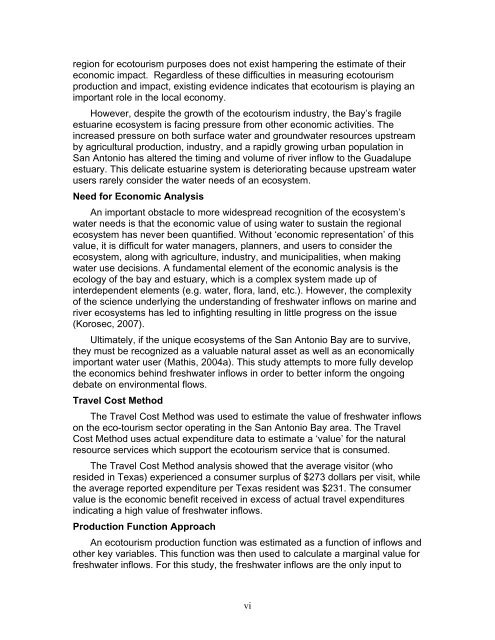The Economic Value of Water and Ecosystem Preservation
The Economic Value of Water and Ecosystem Preservation
The Economic Value of Water and Ecosystem Preservation
Create successful ePaper yourself
Turn your PDF publications into a flip-book with our unique Google optimized e-Paper software.
egion for ecotourism purposes does not exist hampering the estimate <strong>of</strong> their<br />
economic impact. Regardless <strong>of</strong> these difficulties in measuring ecotourism<br />
production <strong>and</strong> impact, existing evidence indicates that ecotourism is playing an<br />
important role in the local economy.<br />
However, despite the growth <strong>of</strong> the ecotourism industry, the Bay’s fragile<br />
estuarine ecosystem is facing pressure from other economic activities. <strong>The</strong><br />
increased pressure on both surface water <strong>and</strong> groundwater resources upstream<br />
by agricultural production, industry, <strong>and</strong> a rapidly growing urban population in<br />
San Antonio has altered the timing <strong>and</strong> volume <strong>of</strong> river inflow to the Guadalupe<br />
estuary. This delicate estuarine system is deteriorating because upstream water<br />
users rarely consider the water needs <strong>of</strong> an ecosystem.<br />
Need for <strong>Economic</strong> Analysis<br />
An important obstacle to more widespread recognition <strong>of</strong> the ecosystem’s<br />
water needs is that the economic value <strong>of</strong> using water to sustain the regional<br />
ecosystem has never been quantified. Without ‘economic representation’ <strong>of</strong> this<br />
value, it is difficult for water managers, planners, <strong>and</strong> users to consider the<br />
ecosystem, along with agriculture, industry, <strong>and</strong> municipalities, when making<br />
water use decisions. A fundamental element <strong>of</strong> the economic analysis is the<br />
ecology <strong>of</strong> the bay <strong>and</strong> estuary, which is a complex system made up <strong>of</strong><br />
interdependent elements (e.g. water, flora, l<strong>and</strong>, etc.). However, the complexity<br />
<strong>of</strong> the science underlying the underst<strong>and</strong>ing <strong>of</strong> freshwater inflows on marine <strong>and</strong><br />
river ecosystems has led to infighting resulting in little progress on the issue<br />
(Korosec, 2007).<br />
Ultimately, if the unique ecosystems <strong>of</strong> the San Antonio Bay are to survive,<br />
they must be recognized as a valuable natural asset as well as an economically<br />
important water user (Mathis, 2004a). This study attempts to more fully develop<br />
the economics behind freshwater inflows in order to better inform the ongoing<br />
debate on environmental flows.<br />
Travel Cost Method<br />
<strong>The</strong> Travel Cost Method was used to estimate the value <strong>of</strong> freshwater inflows<br />
on the eco-tourism sector operating in the San Antonio Bay area. <strong>The</strong> Travel<br />
Cost Method uses actual expenditure data to estimate a ‘value’ for the natural<br />
resource services which support the ecotourism service that is consumed.<br />
<strong>The</strong> Travel Cost Method analysis showed that the average visitor (who<br />
resided in Texas) experienced a consumer surplus <strong>of</strong> $273 dollars per visit, while<br />
the average reported expenditure per Texas resident was $231. <strong>The</strong> consumer<br />
value is the economic benefit received in excess <strong>of</strong> actual travel expenditures<br />
indicating a high value <strong>of</strong> freshwater inflows.<br />
Production Function Approach<br />
An ecotourism production function was estimated as a function <strong>of</strong> inflows <strong>and</strong><br />
other key variables. This function was then used to calculate a marginal value for<br />
freshwater inflows. For this study, the freshwater inflows are the only input to<br />
vi
















